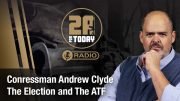
Sixty years ago we had the film Where the Boys Are. Now some people aren’t sure what the boys are, and the latest example is a California bill that would punish large stores for maintaining separate boys’ and girls’ departments.
Designated AB 2826, the legislation’s header reads “Introduced by Assembly Member Low,” which doesn’t pertain to IQ but Silicon Valley’s Democrat politician Evan Low. Mandating “Gender neutral retail departments,” the bill reads, in part, that it requires
a retail department store with 500 or more employees to maintain undivided areas of its sales floor where, if it sells childcare articles, children’s clothing, or toys, all childcare items, all clothing for children, or all toys, regardless of whether a particular item has traditionally been marketed for either girls or for boys, shall be displayed. Beginning on January 1, 2023, the bill would make a retail department store that fails to correct a violation of these provisions within 30 days of receiving written notice of the violation from the Attorney General liable for a civil penalty of $1,000, as provided.
Relating his motivation for this flash of brilliance, Low stated, “I was inspired to introduce this bill after 8-year-old Britten asked, ‘Why should a store tell me what a girl’s shirt or toy is?’” reports Daily Wire.
{modulepos inner_text_ad}
Perhaps Low is just emulating erstwhile presidential candidate Elizabeth Warren, who vowed on the campaign trail to have a nine-year-old MUSS (Made-up Sexual Status) child vet her education secretary pick. But it’s good the child didn’t ask, “Why should mommy tell me when bedtime is?” or “Why should daddy tell me what proper nutrition is?” Who knows what bills would be disgorged then?
On the other hand, if a kid asked, “Why should a school tell me what climate change is?” a lecture tailored to a “deplorable” might be in the offing.
But should Low’s bill become law, a retailer could actually have some fun with it. I’d comply and combine the sections, for instance, but then label different displays as “blue” or “pink.” Were it questioned by a government bureaucrat, I’d ask how he could be so closed-minded as to associate a color with a sex.
Better still might be to label displays as “Little XY” or “Little XX.” Upon interrogation, I’d expound upon how “experts” maintain that one can be genotypically male but phenotypically female. “How could you be such a bigot, sir (or is it madam?), as to assume that the girls entering my establishment don’t have an XY chromosome configuration?”
As for Low, he justified his bill with the usual lowbrow leftist boilerplate. “Clothing and toys sections of department stores that are separated along gender lines pigeonhole children,” he claimed in a press release. “No child should feel stigmatized for wearing a dinosaur shirt or playing with a Barbie doll…. It also incorrectly implies that their use by one gender is inappropriate.”
Of course, Low’s reasoning is hardly unique. Based on the notion that people don’t just have “sex” but also “gender” (which should only apply to words) and that the latter is fluid and is as you and not others perceive it, some parents have refused to divulge the sex of their toddlers and schools have resolved to not address children as “boys” and “girls,” but as campers, readers, athletes, or even purple penguins (seriously).
As for the matter of “pigeonholing” children, what if the child inspiring Low had asked, “Why should people tell me what naked is?” The point?
Just as there are children who believe they’re really the opposite sex, there’s also something called “clinical lycanthropy”: the sense that you’re actually an animal trapped in a human body. Despite this, we still pigeonhole children by putting them in clothing and teaching them language, manners, and the whole range of human norms. We don’t refrain from thus constraining a child because he may one day conclude he’s a ferret.
The reality is that childrearing is all about limiting, instilling values, and pigeonholing. It’s never a matter of whether or not norms will be imposed — only of what norms they’ll be.
Moreover, just as we give a child a species-specific upbringing because he’s a human and not an animal, and might provide a math prodigy with much different interest-specific opportunities and tutelage than a music prodigy, shouldn’t we also give a boy a sex-specific upbringing because he’s male and not female? Is it possible that what has been dismissed as “sex stereotyping” was born of the recognition of the given sex’s characteristic strengths, weaknesses, and psychological needs and serves to cultivate those strengths and mitigate those weaknesses by, in part, satisfying those needs?
Note: That the sexes are innately different is not theory but fact, as the splendid Norwegian documentary The Gender Equality Paradox (below) illustrates.
Interestingly, and a testimonial to Big Tech bias, the above is “age-restricted” by YouTube. What’s not age-restricted is the wholly unscientific MUSS agenda — and it’s destroying children’s lives. While studies show that upwards of 80 percent of “gender”-confused girls and 90 percent of “gender”-confused boys will outgrow their problems as they progress through adolescence, the irresponsible medical establishment still often recommends that “gender dysphoric” children be encouraged to live as the opposite sex, take puberty blocking hormones, and even undergo the body mutilation called “gender reassignment surgery.”
Tragically, such hapless souls have a very high suicide rate. For some of these kids end up like Nathaniel (last name withheld), a teen boy who had his genitalia removed a bit more than a year ago, shortly afterwards regretted it, and now calls it a “Frankenstein” transition that has “ruined” his life.
And that’s what happens, Assemblyman Low, when you don’t pigeonhole children correctly.
Photo: ergeyryzhov/iStock/Getty Images Plus
Selwyn Duke (@SelwynDuke) has written for The New American for more than a decade. He has also written for The Hill, Observer, The American Conservative, WorldNetDaily, American Thinker, and many other print and online publications. In addition, he has contributed to college textbooks published by Gale-Cengage Learning, has appeared on television, and is a frequent guest on radio.


